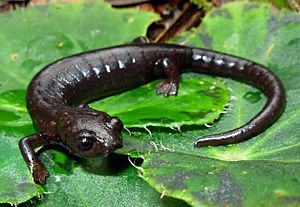Peter's climbing salamander facts for kids
Quick facts for kids Peter's climbing salamander |
|
|---|---|
 |
|
| Conservation status | |
| Scientific classification |
Peter's climbing salamander or Peter's mushroomtongue salamander (Bolitoglossa adspersa) is a special type of salamander. It belongs to a family called Plethodontidae, which are known as "lungless salamanders" because they breathe through their skin and the lining of their mouths.
This salamander is found only in Colombia, meaning it is endemic to that country. It lives in specific places: moist montane forests (forests on mountains) and high-altitude grasslands in subtropical or tropical areas. Sadly, its home is shrinking because of habitat loss, which means it is a threatened species.
Contents
About Peter's Climbing Salamander
Peter's climbing salamander is a fascinating amphibian. Like all salamanders, it has a long body, a tail, and four legs. It's called a "climbing" salamander because it's good at moving around in trees and plants. The name "mushroomtongue" comes from its unique tongue, which is shaped a bit like a mushroom and can shoot out quickly to catch prey.
What Does It Look Like?
While we don't have exact details on its colors, many climbing salamanders have camouflaged skin. This helps them blend in with their surroundings, like tree bark or leaves. They are usually small to medium-sized, perfect for navigating dense forest environments.
Where Does It Live?
This salamander makes its home in the cool, damp environments of Colombia's mountains. It prefers subtropical or tropical moist montane forests, which are forests found at high elevations where there's lots of rain and humidity. It also lives in high-altitude grasslands, which are open areas with grasses found far up in the mountains. These specific habitats provide the moisture and shelter it needs to survive.
What Does It Eat?
Like most salamanders, Peter's climbing salamander is a carnivore, meaning it eats other small animals. It likely feeds on tiny insects and other invertebrates found in its forest and grassland homes. Its special mushroom-shaped tongue helps it snatch up these small creatures quickly.
How Does It Live?
As a "climbing" salamander, Bolitoglossa adspersa spends a lot of its time off the ground. It might live in trees, on large leaves, or among mosses and ferns. Being lungless, it needs to keep its skin moist to breathe. This is why humid environments are so important for its survival.
Facing Challenges: Habitat Loss
The biggest threat to Peter's climbing salamander is habitat loss. This means that the places where it lives are being destroyed or changed, making it hard for the salamanders to find food, shelter, and places to reproduce.
What Causes Habitat Loss?
Habitat loss in Colombia can be caused by several things. For example, forests might be cut down for farming, cattle ranching, or to make space for buildings and roads. Climate change can also affect these habitats by changing rainfall patterns or temperatures, making them less suitable for the salamander.
How Does It Affect Salamanders?
When their habitat is lost, salamanders lose their homes. They might not be able to find enough food, or they might become more exposed to predators. Without suitable places to live and breed, their populations can shrink, putting the species at risk of disappearing forever.
Protecting Peter's Salamander
Protecting Peter's climbing salamander means protecting its unique mountain forest and grassland habitats in Colombia. Conservation efforts often focus on preserving these natural areas and educating people about the importance of biodiversity. By understanding and protecting these small amphibians, we help keep the entire ecosystem healthy.
See also
 In Spanish: Salamandra de Chingaza para niños
In Spanish: Salamandra de Chingaza para niños


